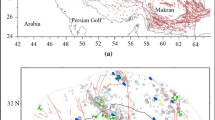Abstract
Earthquake initiation and termination processes are commonly described in terms of barriers and asperities. Barriers fall into two classes: Geometric barriers are associated with places where the orientation of failure surface changes, and relaxation barriers, where stress is low because asesmic creep processes outpace tectonic loading. Geometric barriers fall into conservative and nonconservative subgroups, according to whether finite fault motion can proceed without the creation of new structures or whether it demands the creation of new faulting or void space. The multiple faulting, or ‘fragmentation’, associated with some nonconservative barriers can disrupt fault planes and form asperities. By means of selected examples it is shown that a description in terms of these barriers can help one to visualise the processes of earthquake rupture and its relation to the geological environment.
Similar content being viewed by others
References
Aki, K. (1979),Characterization of barriers on an earthquake fault. J. Geophys. Res.84, B11, 6310–6147.
Archuleta, R. J. (1984),A faulting model for the 1979 Imperial Valley earthquake. J. Geophys. Res.,89, 4559–4585.
Bakun, W. H. andLindh, A. (1985),The Parkfield, California, prediction experiment. Science229, 619–624.
Bakun, W. H. andMcEvilly, T. V. (1979),Earthquakes near Parkfield, California: Comparing the 1934 and 1966 sequences. Science205, 1375–1377.
Bakun, W. H. andMcEvilly, T. V. (1984),Recurrence models and Parkfield, California, earthquakes. J. Geophys. Res.89, B5, 3051–3058.
Bally, A. W.,Seismic expression of structural styles. A.A.P.G. Studies in Geology Ser. No. 15, vol 3, 1983.
Cisternas, A., Dorel, J. andGaulon, R. (1982),Models of the complex source of the El Asnam earthquake. Bull. Seism. Soc. Am.72, 2245–2266.
Cockerham, R. S. andEaton, J. P., ‘The April 24, 1984, Morgan Hill earthquake and its aftershocks: April 24 through September 30, 1984’, (eds., J. Bennett and R. Sherburne),The 1984 Morgan Hill, California, earthquake. Calif. Dept. Conserv., Div Mines Geol., Spec. Publ.68, 1985.
Das, S. andAki, K. (1977),Fault plane with barriers: A versatile earthquake model. J. Geophys. Res.82, 5658–5669.
Das, S. andScholz, C. (1983),Why large earthquakes do not nucleate at shallow depths. Nature305, 621–623.
Eyidogen, H. andJackson, J. (1985),A seismological study of normal faulting in the Demirci, Alasehir and Gediz earthquakes of 1967–70 in Western Turkey: Implications for the nature and geometry of deformation in the continental crust. Geophys. J. Roy. Astr. Soc.,81, 569.
Husseini, M. I., Jovanovich, D. B., Randall M. J. andFruend, L. B. (1975),The fracture energy of earthquakes. Geophys. J. Roy. Astr. Soc.43, 367–385.
Kanamori, H., ‘Use of seismic radiation to infer source parameters,’ Proc. Conf. III.Fault mechanics and its relation to earthquake prediction. U.S. Geol. Surv. Open-file Rept. 78-380, 1978.
King, G. C. P. (1983),The accommodation of large strains in the upper lithosphere of the Earth and other solids by self-similar fault systems: The geometrical origin of b-value, Pure Appl. Geophys.121, 761–1093.
King, G. C. P. andBrewer, J. (1983),Fault related folding near the Wind River thrust, Wyoming, U.S.A. Nature306, 147–150.
King, G. C. P. andNabelek, J. (1985),The role of bends in faults in the initiation and termination of earthquake rupture. Science228, 984–987.
King, G. C. P., Ouyang, Z. X., Papadimitriou, P., Houseman, G., Jackson, J. A. Virieux, J., Soufleris, C. andDeschamps, A. (1985),The evolution of the Gulf of Corinth (Greece): An aftershock study of the 1981 earthquakes. Geophys J. Roy. Astr. Soc.80, 677–693.
King, G. C. P. andStein, R., ‘Surface folding, river terrace deformation rate and earthquake repeat time in a reverse faulting environment: The Coalinga, California, earthquake of May 1983’, inThe 1983 Coalinga California earthquake. Calif. Div. Mines Geol. Spec. Publ. 66, Sacramento, Calif., 1983.
King, G. C. P. andVita-Finzi, C. (1981),Active folding in the Algerian earthquake of 10 October 1980. Nature292, 22–26.
King, G. C. P. andYielding, G. (1983),The evolution of a thrust fault system: Processes of rupture initiation, propagation and termination in the 1980 El Asnam (Algeria) earthquake. Geophys. J. Roy. Astr. Soc.77, 915–933.
Lindh, A. G. andBoore, D. M. (1981),Control of rupture by fault geometry during the 1966 Parkfield earthquake. Bull. Seism. Soc. Am.77, (1), 95–116.
Rice, J. R., ‘The mechanics of earthquake rupture’, in (eds. A. M. Dziewonski and E. Boschi),Physics of the Earth's Interior. Proc. Int. School Physics. ‘Enrico Fermi,’ Course 78, 1979, Italian Phys. Soc., North Holland Publ. p. 555–649, 1980.
Scholz, C. H. (1982),Scaling laws for large earthquakes: Consequences for physical models. Bull. Seism. Soc. Am.72, (1), 1–14.
Seeber, L. andNicholson, C.,Slip along discontinuous wrench fault and the role block rotation in seismic and interseismic deformation. Lamont-Doherty Geol. Observ., Palisades, N.Y. (Preprint), 1985.
Sibson, R. H. (1982),Fault zone models, heat flow, and the depth of distribution of earthquakes in the continental crust of the United States. Bull. Seismol. Soc. Am.72 (1), 151–163.
Sibson, R. H. (1983),Continental fault structure and the shallow earthquake source. J. Geol. Soc. London140, 741–767.
Sibson, R. H. (1985),Stopping of earthquake ruptures at dilatational fault jogs. Nature 316.
Smith, R. B. andBrunhn, R. L. (1984),Intraplate extensional tectonics of the eastern basin-range: Inferences on structural style from seismic reflection data, regional tectonics and thermal-ductile deformation. J. Geophys. Res.89, (B7), 5733–5762.
Stein, R., andKing, G. C. P. (1984),Seismic potential revealed by surface folding: The 1983 Coalinga, California, earthquake. Science224, 869–872.
Stein, R. S. ‘Evidence for surface folding and subsurface fault slip from geodetic elevation changes associated with the 1983 Coalinga, California, earthquake’Proc. Workshop XXVII. U.S. Geol. Surv. Openfile Rept. p. 85–44, 1985.
Sykes, L. andSeeper, L. (198?),Great earthquakes and great asperites, San Andreas Fault, Southern California. Pure Appl. Geophys. (not available at press time).
Vita-Finzi, C., andKing, G. C. P. (1985),The seismicity, geomorphology and structural evolution of the Corinth area of Greece.Phil. Trans. Roy. Soc. London, A314, 379–407.
Walcott, R. I. (1984),The kinematics of the plate boundary zone through New Zealand: A comparison of short-and long-term deformations, Geophys. J. Roy. Astr. Soc.79, 613–633.
Author information
Authors and Affiliations
Rights and permissions
About this article
Cite this article
King, G.C.P. Speculations on the geometry of the initiation and termination processes of earthquake rupture and its relation to morphology and geological structure. PAGEOPH 124, 567–585 (1986). https://doi.org/10.1007/BF00877216
Received:
Accepted:
Issue Date:
DOI: https://doi.org/10.1007/BF00877216




